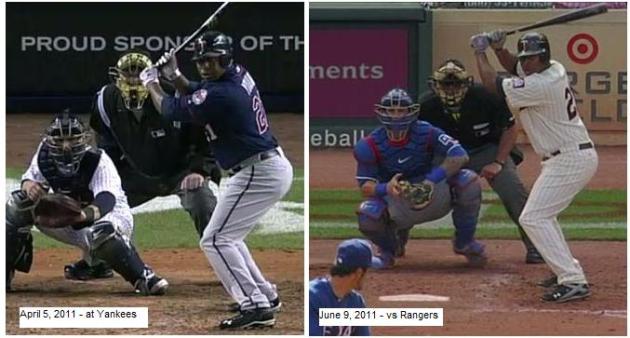It was less than two weeks ago in this space that I chronicled Delmon Young’s swing, which had become
slower, and that his timing was all sorts of messed up.
According to observations from FSN analyst Roy Smalley Young was putting too much of
his weight on his front foot, leaving him to hit with just his hands. This left
him unable to drive the ball in the manner in which he did just a year ago. His
power numbers confirmed this as he was slugging .257 as recently as June
5.
With the problem identified, it would only be
a matter of time before Young would respond and make the necessary adjustments.
Because he had been reportedly standoffish about his mechanics, that “matter of
time” could have been weeks or months before corrections would be made.
Surprisingly, it did not take him long to incorporate a new approach at the
plate.
After returning home from the latest road
trip, Young unveiled a new set-up in his stance. It is minor but - after going
8-for-16 with a double and a home run in the Rangers series - it has become
obvious that the small change has quickly yielded some positive results for the
left fielder.
Let’s take a look at Young’s new starting
point:

On the left you see Young’s pre-Rangers series
hand set-up. Young is holding the bat at a 45-degree angle with his hands at
shoulder level. Meanwhile, during the Rangers series, Young made a slight
adjustment to his set position, raising his hands almost above his head while
holding the bat nearly parallel to the ground.
What does raising their hands do for a
hitter?
When Toronto's Jose Bautista overhauled his
swing, one of the more critical changes he made was raising the level of his
hands. Frankie Piliere, a former scout with the Texas Rangers, explained why this aspect of his swing improved his
power:
“Overall, it appears he has made an effort to get his top hand more involved and get his hands moving through the zone quicker in general. To do that, he has put his hands in a higher position and is creating much more leverage. Rather than low and close to his body, we now see him with his hands not just higher but also further away from his body. So, before he even begins his swing, he is in a stronger, loaded position with his hands back.”
So the new hand placement above his helmet
provides Young not only with a better timing mechanism, allowing him to get his
hands and hips synched more readily, but from that location Young is in a
position to leverage his top hand better in his swing. This, in theory, should
translate to an increase in power.
If we compare the two swings in the video from
the side, we see that while Young eventually brings his hands to almost the same
load position but, unlike the clip from earlier in the season, Young can
generate more power with his hands starting at a higher point:

June 11, 2011 - vs
Texas Rangers

May 31, 2011 - at
Detroit Tigers
Getting his hands through the zone quicker
also means better plate coverage on the inner-half. One of his biggest flaws at
the beginning of the year was his inability to pull pitches. However as of late
he has echoed the hard-hittin’ version of himself from 2010, the one who drove
the ball into right field with authority. Re-awaking that could mean some
immediate offensive contributions for the surging team.
Of course, this doesn’t smooth over the holes
in the other aspects of his game.
Although Young has made the adaptation in his
mechanical approach that could set off a potential big streak for him, there are
also other factors - such as his plate discipline - that may keep him from
taking off. Young’s 2010 vast improvement was aided by a reduction in the frequency of
strikeouts. So far this year, Young has reverted back to his pre-2010
tendencies. At 25-years-old with nearly 2,500 plate appearances under his belt,
this part of his game is unlikely to go away.
It is quite a quandary for the Twins at this
juncture. On one hand, you have a young, right-handed power source that, if the
past few at bats are any indications of things to come, could be a big factor in
lifting the team back into AL Central contention. On the other hand, he has
demonstrated lackadaisical play in the field, been vocal about his displeasure for DH-ing (a position he
is best suited for) and the Twins have a versatile outfielder in Ben Revere who
offers speed and defensive upgrade.
Either way, if Young can add a few more extra
base hits to the ledger over the next couple of weeks, he could be a very
valuable asset to the Twins – be it as a middle-of-the-lineup contributor or as
a potential trading chip.

2 comments:
Great analysis as always. Hopefully this is the beginning of a hot streak for Delmon, regardless of whether it's simply to increae his trade value or to help lead the offense like he did last year.
Will Cuddyer have more trade value with his leadership intangibles than Young? Its hard for me to see the Twins trading Cuddy (one of Gardy's guys) but it has to be an option. Then they could move Young/Revere/Kubel to RF. It might be a moot point if they keep playing like they have. Go Twins!
Post a Comment